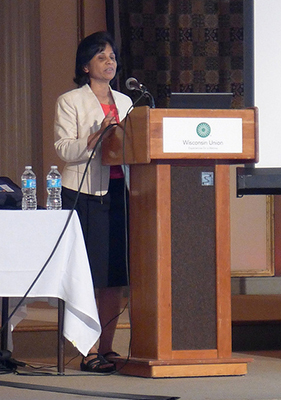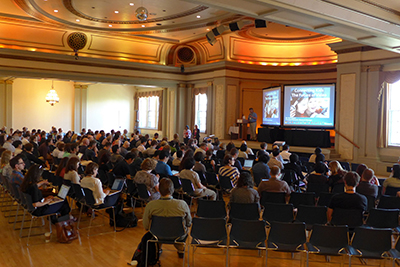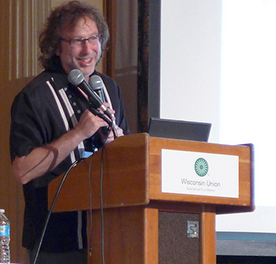Puntambekar Brings International Conference on Computer-Supported Collaborative Learning to UW
March 4, 2014

WCER Researcher Sadhana Puntambekar, pictured delivering a welcome speech at the 2013 International Conference.
This week marks a significant milestone for Sadhana Puntambekar. Amazon.com will begin selling a two-volume account of the proceedings of the 10th International Conference on Computer-Support Collaborative Learning (CSCL), eight months after Puntambekar served as chief organizer of the conference, which took place for the first time at the University of Wisconsin–Madison.
“It marks the end of four years of work,” Puntambekar said.
Puntambekar, a professor of educational psychology UW–Madison and researcher at the Wisconsin Center for Education Research (WCER), has served as an executive officer for the International Society of the Learning Sciences (ISLS) since 2011. She volunteered to serve as conference chair of CSCL 2013 with the stipulation that it be hosted Madison. With the offer, she hoped to promote UW–Madison’s learning sciences program and give its students a unique opportunity to attend an important international conference without having to leave campus.
The biennial CSCL, which in previous years took place in Taiwan, Greece, Norway, and Canada, seeks to explore the nature of collaborative learning in technologically-supported environments from empirical-, theoretical-, conceptual- and design-based perspectives. Because of its focus on the growing and interdisciplinary field of technology-based collaborative learning, the conference attracts hundreds of eminent researchers from around the globe. So when the ISLS approved Puntambekar’s proposal, she and her colleagues at UW–Madison knew they had two years of intensive planning ahead of them.
“For the conference to succeed, the entire organizing committee had to be completely committed,” Puntambekar said. “Fortunately, people were really open to volunteer and be a part of it, but it was a lot of extra duties for people who were already very busy.”

CSCL conferences attract leading researchers from around the globe. For CSCL 2013, the totals were impressive: hundreds of researchers from 36 countries on six continents were in attendance.
That list of busy people includes Puntambekar, who is in the middle of a multi-year research study funded by the National Science Foundation (NSF) focused on understanding the cognitive and contextual issues in integrating digital text in middle school science classes.
A busy man himself, Mitchell Nathan serves as professor of learning sciences in UW–Madison’s educational psychology department and is a fellow WCER researcher. He became one of Puntambekar’s earliest recruits when he signed up to serve as a program co-chair. Dozens of UW–Madison professors and a handful of WCER researchers, including Martha Alibali, Sharon Derry, Chuck Kalish, Eric Knuth, Kurt Squire, and Richard and Erica Halverson, joined in.
The work, though copious and difficult, paid off, Nathan said. Last June, faculty from scores of American universities and 36 countries on six continents arrived in Wisconsin for CSCL 2013. The conference’s theme was “To See the World and a Grain of Sand: Learning across Levels of Space, Time, and Scale.” Inspired by William Blake’s poem “Auguries of Innocence,” the theme reflected the rising importance of studying computer-based collaborative learning at multiple levels, from the theoretical to the methodological, not to mention the epistemological and technical, Nathan said.

WCER Researcher Mitchell Nathan served as one of three program co-chairs for CSCL 2013.
“A huge part of the field – and a huge part of the conversation surrounding the future of education – is how do we allow learners and instructors to do new things to better engage students in activities that will promote their learning?” Nathan asked. “In other words, how does education stay technologically relevant and innovative without losing impact?”
As an example of the content shared at the conference, Nathan mentioned one presentation that explored using cell phones in high school physics classrooms.
“The phones that most students keep in their pockets all class may be the most powerful technology in the classroom, and it could potentially be used as a wonderful teaching tool,” Nathan said. “But education exists in a socio-political organizational context; you can imagine the conversations that might have to happen – in a school where cell phone use isn’t permitted – to allow their use by a teacher promoting the value of that technology. It also raises other questions: how does the introduction of the cell phone impact instruction and student engagement? How does it affect the curriculum – what will be that classroom’s learning activities?”
The creators and adopters of technology for educational purposes shouldn’t use new technology just for its own sake, but rather should aim for better support of learning practices, social exchanges, and educational interactions. In that regard, Puntambekar said, the conference moved the field forward.
“Many of the conference papers excelled at combining different methods to document and analyze collaborative learning taking place through new technology,” she said. “We’re showing that, while any single individual in a group may not be able to solve a particular problem, if they respect and respond to each other’s ideas, together, they can.”
To Nathan, just as important as advancing the field’s knowledge base was how the conference helped strengthen the CSCL community.
“The number one thing you could hope for in putting together a conference is building community. As an organizer, you’re hoping it strengthens the professional scholarly body so that it’s able to address the toughest challenges of our day. If some cool technology transfer happens, and some cool collaboration happens, that’s a bonus. But if the community is strengthened, then that’s going to be the most robust outcome,” Nathan said. “It’s ironic, but that requires gathering all these experts in computer-assisted communication and collaboration into one physical place. Being in the same place at same time – maybe eating a brat and taking in the sunset over Lake Mendota – that’s still the best way to build a community.”
Volume 1 and Volume 2 of the conference proceedings are available for free in digital format on the conference’s website and at Lulu.com. Print versions will soon go on sale at Amazon.com.


